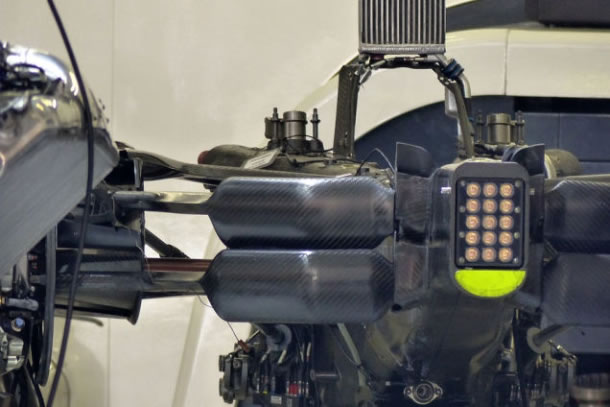McLaren "Mushroom"
Inovative Rear Suspension 2014
One of the main technical talking points of the first pre-season test at Jerez has been McLaren's rear suspensions. As a closer look at the rear suspension reveals this is an area where McLaren clearly haven't go conservative. Instead they come up with something that is very hard to compare with anything seen on other Formula One cars, ever. They have come up with the first innovation of the year by creating rear suspension wishbones that are very different to what we usually see. Normally, wishbone suspension elements are build as horizontal teardrop design, almost parallel to the reference plane in order to minimize drag created by the suspension elements. McLaren's version is completely different and doesn't look like they wanted to reduce the drag at all, quite opposite. So, what McLaren have done is to create a wishbone in the shape of a mushroom lying down on its side with "umbrella" side downstream. McLaren is using some unusually profiled rear section of the upper and lower rear arms of rear suspension pieces and they are actually blocking free flow of air trough Coke bottle area, an area where, until now, engineers where trying to make air flow as clean as possible without any obstruction. It looks as if McLaren may have found the latest rule-bending innovation that other teams will soon be scrambling to duplicate. Some teams are preparing a protest about it and at the same time preparing their own version in their wind tunnels. Such is the way Formula 1 goes. Some technical commentators call them "mushrooms" some "butterfly" and other use name "blockers".
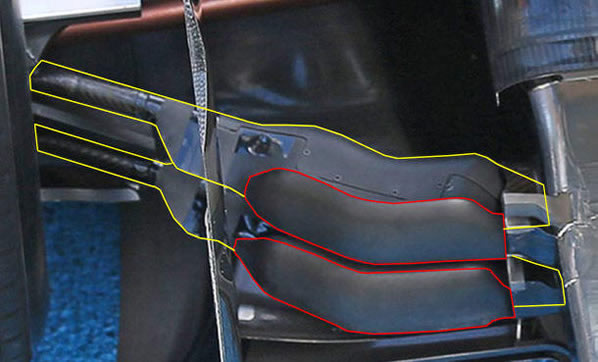
On the pictures you can see 2 structures in front of the rear wing (highlighted in red). Because on image like that you can't see depth of field, this structures look like the suspension wishbones have been flipped vertically. But actually the team have simply designed rear arms with much boxier version of trailing edge, normal, thinner leading edge, and all structure getting thinner outboard at the point in line with the rear wing endplate (highlighted in yellow). These boxier parts are mushrooms or blockers.

How they work?
This concept is designed both to give more downforce at low speed and reduce drag at high speed. The rear beam wing previously did this job, but the 2014 regulations have banned that so teams are looking for new ways to make up for it. Mushrooms are designed to simply restrict and choke the airflow coming out of the Coke bottle area when it gets to the upper side of the diffuser. As air flows around these pieces located above and forward of the diffuser, this creates an low pressure area behind the mushroom umbrella and above diffuser, which help to pump out more air trough diffuser, speeds up the air underneath the car, increase the mass flow out of the rear diffuser generating more downforce from the undertray and diffuser. Major function is not to generate downforce on its own but to help undertay and diffuser to create it and to allow the team to be more aggressive with the diffuser and stops it stalling at lower ride heights. These two elements will also create a degree of drag caused by airflow blockage which will increase fuel consumption over a race distance.
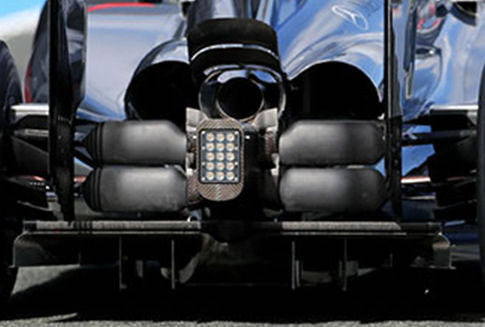
To make it aerodynamically more interesting, the horizontal axis of the mushroom is rotated by 5 degrees (front side up), so that the backside of the mushroom umbrella pulls air upwards, instead of being aerodynamically neutral. Each mushroom arm in itself generates a stagnation point ahead of the vertical flap and creating a vortex behind it. It is important to note though that the entire system only works because the flow is constrained in the "box" between the endplates of the rear wing, rear wing on the top and diffuser at the bottom. All combined with an extra wing profile with the span of diffuser itself and very short chord of wing mounted just ahead of the diffuser will create an upwash that helps reduce the pressure behind the suspension, helping the diffuser to extract more air from under the floor.
 Interestingly, the airflow around these "blockers" changes with the speed of the car. When the car runs at slower speed and when the car is at higher ride height, downforce is reduced and the suspension is uncompressed, the mushrooms will almost completely close the gap between them, forming an almost solid wall at the top of the diffuser, reducing the pressure and helping it to work at low speed, generating additional downforce.
Interestingly, the airflow around these "blockers" changes with the speed of the car. When the car runs at slower speed and when the car is at higher ride height, downforce is reduced and the suspension is uncompressed, the mushrooms will almost completely close the gap between them, forming an almost solid wall at the top of the diffuser, reducing the pressure and helping it to work at low speed, generating additional downforce.
Opposite, when the car is at higher speed and the suspension is compressed, a gap will open up between mushrooms which will reduce drag. So, this will give you more downforce under braking and in slower corners and less drag at 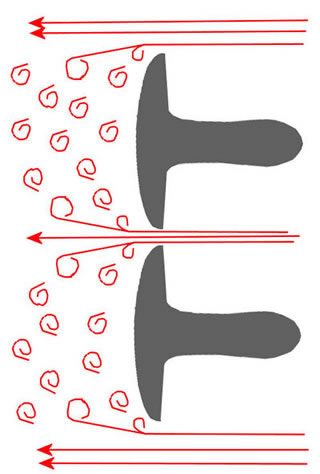 high speed.
high speed.
This could be McLaren's secret weapon because, if it does work, it is not something that can be copied easily as it is dependent on a number of design parameters at the rear of the car. McLaren have designed their rear suspension so that these rear wishbones are as much to the back as possible, with attachments all the way back of the gearbox housing. They have also been unable to enclose the driveshaft with the lower wishbones like Red Bull and Ferrari have done. It is exactly this suspension geometry that would make it extremely hard for other teams to simply copy it as it would require redesigning the gearbox, the rear suspension mountings and the suspension wishbones, creating a combined impact on aerodynamics and mechanical behavior that will take time to verify and optimize.
After begining of the season it’s not clear whether this has given them the rear end downforce that every team is looking for under the 2014 rules, now that smaller rear wings and the lack of blown diffusers have made the rear of the cars more unstable. The cost in terms of drag appears quite high. McLaren's unique suspension design has been investigated by other teams and they can see the downforce it produces, but also the huge amounts of drag, so they have not adopted it.
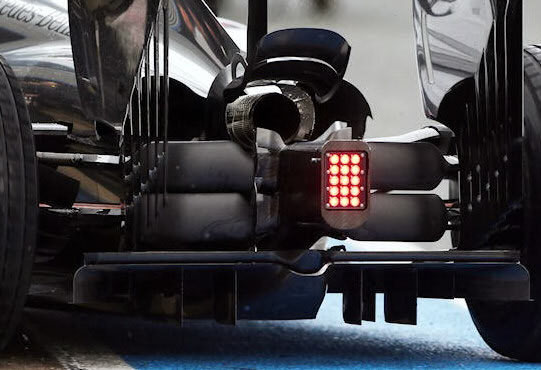
Also, the use of the "suspension blockers" meant the team had to place the cooling outlets higher than is desirable. The hot, slow moving airflow dispatched by the cooling outlets can be destructive to the rear wing air flow, reducing the effect of the low pressure airflow under the wing, unbalancing the car during braking and cornering.
Everybody is questioning its legality!
The rear suspension of the McLaren MP4-29 has come under close scrutiny. At least one team has asked the governing body for clarification that the design complies with the regulations relating to the maximum number of arms in the rear suspension. We understand from the FIA's technical department headed by Charlie Whiting that he accepts that it's within the rules. But there are quite a few other teams thinking that they're going to protest it once we get to the first race because the teams can go to Charlie Whiting and ask him for opinion but he can only express an opinion; he is not the final arbiter of what is and is not legal - and we've seen his opinion overturned before. Therefore a team must file a protest if they want action to be taken. 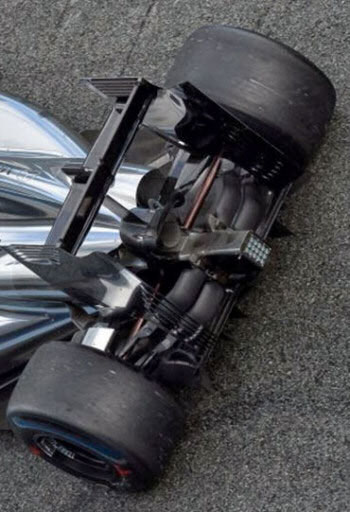
The exact purpose and way of work of the mushrooms is not completely clear but their purpose certainly is aerodynamic.
The legality question is:
with the primary purpose of suspension to suspend the car and keep the wheels on, whether its other purpose is for aerodynamic gain? They're clearly also for aerodynamic benefit, so it's certainly in contravention of the spirit of the regulations. Given that you wouldn't normally have a suspension part - a compressive part - that has a box on it, so that calls the primary purpose of whether it's a suspension or aero part into question.
So I think we might see a protest against the McLaren cars at the Australian Grand Prix because it all centers on these wishbones, which are to support the car.
These elements are illegal if they are simple covers that are attached to the suspension elements. However, if they are structural parts of the wishbones, they can be legal. If they are just a covers then it is hard to understand how the design complies with the 2014 F1 technical regulations relating to the suspension components. The seemingly clearly written article 10.3.4 states that:
10.3.4 Non-structural parts of suspension members are considered bodywork.
The thing to consider here is that the wishbones are moving elements and so the gap between both elements will change based on the attitude of the car. This means that the entire shape must be structural, as otherwise the thick fairing would be considered as banned moving bodywork as per Article 10.3.4 of the Technical Regulations. And McLaren is not so stupid.
If the ‘mushrooms’ are considered to be bodywork then article 3.15 comes into force which states that:
3.15 Aerodynamic influence :
With the exception of the driver adjustable bodywork described in Article 3.18 (DRS) (in addition to minimal parts solely associated with its actuation) and the ducts described in Article 11.4 (BRAKE DUCTS), any specific part of the car influencing its aerodynamic performance :
a) Must comply with the rules relating to bodywork.
b) Must be rigidly secured to the entirely sprung part of the car (rigidly secured means not having any degree of freedom).
c) Must remain immobile in relation to the sprung part of the car.
Any device or construction that is designed to bridge the gap between the sprung part of the car and the ground is prohibited under all circumstances.
No part having an aerodynamic influence and no part of the bodywork, with the exception of the skid block in 3.13 above, may under any circumstances be located below the reference plane.
With the exception of the parts necessary for the adjustment described in Article 3.18, any car system, device or procedure which uses driver movement as a means of altering the aerodynamic characteristics of the car is prohibited.
The ‘mushrooms’ being mounted to the wishbones are clearly unsprung and clearly move. However there is talk in the paddock that somehow McLaren has found a loop hole in the regulations which mean that these devices are not bodywork and thus article 3.15 does not apply.
But it gets more complex, if the mushrooms are considered part of the suspension rather than as bodywork then they must comply with article 10.3.1 which stipulate limitations to the cross section of the suspension arms, saying its longest dimension (main axis) may not be more than 100mm, and this axis can only be up to 5° off from being parallel to the reference plane. On top of that, the section must also be parallel among its main axis:
10.3 Suspension members :
10.3.1 With the exception of minimal local changes of section for the passage of hydraulic brake lines, electrical wiring and wheel tethers or the attachment of flexures, rod ends and spherical bearings, the cross-sections of each member of every suspension component, when taken normal to a straight line between the inner and outer attachment points, must :
a) Intersect the straight line between the inner and outer attachment points.
b) Have a major axis no greater than 100mm.
c) Have an aspect ratio no greater than 3.5:1.
d) Be nominally symmetrical about its major axis.
The major axis will be defined as the largest dimension of any such cross-section.
10.3.2 Suspension members having shared attachment points will be considered by a virtual dissection into discrete members.
10.3.3 No major axis of a cross section of a suspension member, when assessed in accordance with Article 10.3.1, may subtend an angle greater than 5° to the reference plane when projected onto, and normal to, a vertical plane on the car centre line with the car set to the nominal design ride height. The major axis will be defined as the largest axis of symmetry of any such cross-section. The length of the intersection of this axis with the cross-section must not be less than 95% of the maximum dimension of the section.
Its length is likely to be very close or exactly 100mm, while the height looks to be of similar dimension. This means the section has an aspect ration of close to 1:1, much less than the maximum allowed 3.5:1, therefore making the entire part legal.
It has been described by some engineers in the paddock as a head scratcher as to how it can be considered legal and comply with either 3.15 or 10.3.1, but many are already beginning to think about implementing their own version. If the FIA deem it to be legal all teams will try to implement this solution. It may be that the only way those teams will be able to find out how the McLaren design is legal to protest the car, something that may happen at the Australian Grand Prix in March 2014.
Back to the top of the page


